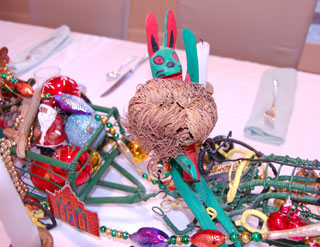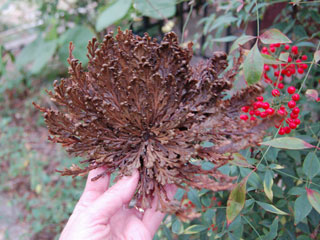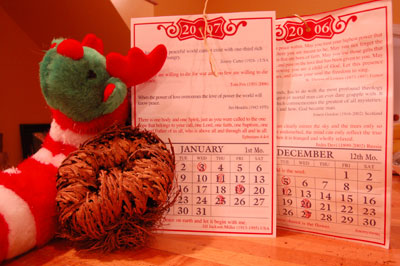Human Flower Project
Saturday, December 30, 2006
Rose of Jericho—For Openers
The Resurrection Plant breathes life into the dead of winter.

Before: Odontospermum pygmaeum after years in a brown bag
Photos: Julie Ardery
Several winters ago at the turn of the year, we visited the shrine of Don Pedrito, famed folk healer of the Texas-Mexican border, down near Falfurrias. At the tiny gift shop next to the curandero’s shrine, we spotted what looked like a ball of dry, dead moss. What’s this?
“Rose of Jericho,” we were told, a plant that comes back to life, bringing good health and fortune. Sold to the gringa from Austin.
We brought this weird knot of vegetation home in a paper bag, and it sat on a shelf up high, untouched, until last week. This Christmas we would be traveling and couldn’t stand the thought of getting a tree and decorating it only to abandon it for the holidays. Then we spotted the old brown bag, took it down, and pulled out the Rose of Jericho. Maybe it could provide a miracle of Christmas greenery.
 After: Two days in warm water—Ta-da!
After: Two days in warm water—Ta-da!
Submerged in a bowl of lukewarm water, over the next few hours and days it “bloomed.” The dry fist opened wide, turning a dark olive. Amazing. We changed the bowl-water each day to keep our “rose” fresh, and on the morning we left town splashed some of the healing water all four wheels of the car we’d be driving 2500 miles. We left the splayed out Rose of Jericho on a couple of paper towels to dry out as we’d been told to do, and returned—safely and happily—a week later, finding it brown and balled up again.
The name Rose of Jericho is used for several plants with these same magical behaviors: “Anastatica hierochuntica of the family Cruciferae (mustard)” and Odontospermum pygmaeum, “a member of the family Asteraceae (aster).” Ours appears to be Odontospermum pygmaeum or Selaginella lepidophylla.
An article from Garden and Forest (1892) says Resurrection Plants were brought to Europe from Asia Minor in the Middle Ages. “Many specimens were brought home by the Crusaders, and so highly were they prized, for semi-religious reasons, that they were often represented in the paintings on old shields which still exist in France.” (We quite like the idea of “semi-religious” and would describe the Human Flower Project as such.)
A semi-philosophical account of Rose of Jericho is of interest, too:
“For long periods, these ‘roses’ live in desert regions, growing and reproducing as any other plant until the environment no longer supports an adequate existence. When this time comes, they lose moisture, retract their roots from the soil and allow the desert winds to carry them across the desert, until one day they arrive in a place where they can continue to grow and spread. You could say they feel their way through this process, as they don’t necessarily remain in the first place they stop, but feel into the nature of the place to see if it is adequate to enhance growth. There they may stay, and grow, or indeed they may move again many times. But at all times, they feel, and trust to the movement that surrounds them.” Balled up, rolling, or in the flow.
A sales site from the UK considers the plant Mexican, claiming that Rose of Jericho has been “known since antiquity by its Nahuatl name Texochitl yamanqui and also as Flor de piedra or Doradilla. In Yucatan it is called Muchkok.” And this source refers to Selaginella lepidophylla as the Resurrection Plant, with a tale of the baby Jesus and Mother Mary. (Here’s a botanical look at it.)
Clearly, there are a number of wild things with this capacity for rebirth, a quality that has inspired knights and looters, voodoo priests and botanists alike. German-speakers seem especially keen on Anastatica hierochuntica. If our stills don’t thrill, check out this wonderfully choppy video of the Rose Anastacia opening.

After-after: Redried and ready for the next miracle-assignment
We weren’t the first to make Resurrection Plant part of a Christmas celebration and/but we intend to perpetuate the custom after this year’s “semi-religious” trial. A writer from Holland contends the plant “is said never to die, and thus being kept in families for over generations.”
To all of you, may the New Year bring generations of faith, experimentation, wonder.




